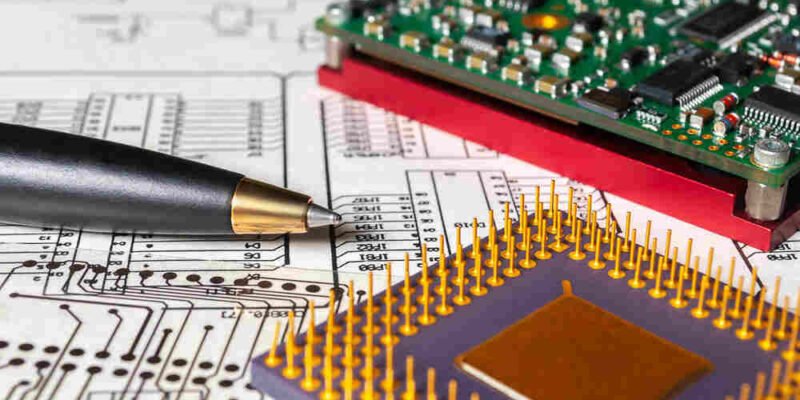An MCPCB can be defined as a PCB with a metal base, normally aluminum, copper, or an alloy. The metal cores are designed to displace heat away from components. They also serve as an effective heat sink for power-hungry components.
MCPCBs can operate at higher temperatures than traditional FR4 PCBs. They can also handle higher temperatures than other types of PCBs. They also provide enhanced overall performance compared to these alternatives.
Key Constituents of MCPCB
Metal Core
The basic definition of the MCPCB is its inclusion of a metal core. The metal core functions like a heat path, and in this manner, it takes away the heat from components. The most commonly used metals are aluminum, copper, and steel alloy. This material is light in weight and provides a low-cost method, especially for LED applications. Remarkable chemical properties show thermal conductivity, whereas it is priced very high. Steel alloy would be used in those applications where extra rigidity is needed.
Dielectric Layer
This layer provides electrical insulation between the metal core and the circuit layer. It has to possess good thermal conductivity attributes to effectively transfer heat from the components to the metal core.
Circuit Layer
It is the thing on which the electronic components are mounted. It is usually copper in nature and etched into creating a circuit pattern.
Advantages of Using MCPCBs
Better Heat Dissipation
One of the advantages associated with MCPCBs includes effective heat dissipation. High temperatures can harm components in power electronics and LED lighting. MCPCBs are useful in these situations.
Improved Reliability and Durability
MCPCBs’ thermal management enhances the reliability of electronic components. It also increases their lifespan. Lower thermal stress leveled to components leads to fewer failures and products that would last longer. This is important for a very high percentage of applications, mainly in the automotive and aerospace industries.
Higher Power Density
The cooler component in MCPCBs allows for increased power density. This enables more compact designs with higher electronic power capabilities. This is what makes the increasing demands for miniaturization in electronics increasingly addressed.
Improved Mechanical Stability
The metallic core improves the mechanical firmness of the board and increases resistance to warping or cracking. In such an environment, the large temperature variation can withstand this property. Hence, proved to be useful in highly thermal challenging environments.
Solution for Economical Cooling
An MCPCB allows less need for additional cooling solutions, such as a heat sink or a fan. Again, it reduces overall costs and offers a less complicated design.
Fields of Application of MCPCBs— in LED Lighting
MCPCBs are widely accepted in LED lighting applications. They demonstrate good heat dissipation, making them a reliable choice for these applications. LEDs generate a significant amount of heat. MCPCBs help maintain the optimal operating temperature for LEDs. Thus, LEDs shall work properly with longer life expectancy.
Power Converters
Power converters and inverters find their high application in this category, generating a lot of heat. MCPCB’s design for managing thermal loads helps increase efficiency. This, in turn, enhances reliability, surpassing what’s offered by other designs in the market.
Automotive Electronics
The automotive industry requires high reliability and high performance. MCPCBs are used in applications that require heat management, such as headlights. They are also used in engine control units and other similar applications.
Applications related to aerospace and defense possess infinite reliability. MCPCBs provide the best possible thermal management for electronic systems. This enables operation in hostile environments where high reliability and performance are crucial.
Renewable Energy
It is applied to renewable energy systems, particularly solar power inverters. MCPCBs aid in heat dissipation to ensure systems continue working optimally and last long.
Number of Design Considerations for MCPCB
MCPCB design involves careful consideration of key factors. This maximizes benefits, including effective thermal management.
This is, hence, a very important feature of the dielectric layer. The higher the thermal conductivity, the better the heat transfer from components to the metal core.
Thickness of Layers
The two layers, the metal core and the dielectric layer would have to be optimized per application. A thicker metal core improves heat dissipation efficiency. However, it increases the weight and cost of the final product.
Circuit Design
Proper circuitry design is necessary to harness the largest advantage of MCPCBs. The components have to be laid out so that good heat transfer is allowed between components. The circuit layout is required to lower the thermal resistance between the components.
The assembling process of MCPCBs is quite laborious compared to conventional PCBs. Producing good quality and reliable MCPCBs involves special equipment and the best hands. Cooperation with experienced manufacturers is always key to realizing the best results.
Comparison with Traditional PCBs
Heat Management
- MCPCBs: Good application in high-power applications because the core allows good dissipation.
Power Dissipation Capabilities
Mechanical Stability
- MCPCBs: The metal core provides better mechanical stability.
- Traditional PCBs: Mechanical deformation, cracking under thermal stress.
- Cost
- MCPCBs: Higher initial investment may be a cost-saving investment in cooling solutions.
- Traditional PCBs: Lower initial investment but might cost higher in more cooling implements.
Areas of Preferred Application
- MCPCBs: Those needing the best application areas and efficient thermal management.
- Traditional: This will suit all purposes where medium thermal demands are required.
Conclusion
Kingsun PCB MCPCBs (Metal-Clad Printed Circuit Boards) ensure reliability and performance. They also provide longevity in today’s electronic world. MCPCBs offer a better solution for the thermal management of high-powered applications. MCPCBs add value to LED lighting. They’re even more crucial in auto electronics. Integrate MCPCBs into your designs and realize higher power density and better reliability. This integration also provides cost-effective cooling solutions.
Do Read: Telekom FintechAsianet: Revolutionizing Digital Finance Integration













